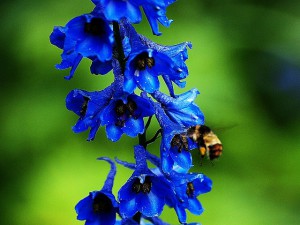Loss of a Single Bee Species Can Harm Plants
Researchers have identified another mechanism linking bee population decline to reduced biodiversity. A study published in the Proceedings of the National Academy of Sciences this week showed that a decrease in a single bee species could result in reduced flower pollination rates, even when other species population numbers were unaltered. The reason behind this lack of effective pollination is that without the careful species balance within the pollinator realm, bees are less faithful to a single flower species. Without the constant interspecies competition, many remaining bees took advantage of the wide variety of flowers by visiting many different species, thus decreasing the likelihood that intraspecific pollen would reach the correct flower. The larkspur, for example, showed decreased pollination rates because bees that once would have serially visited that species now carried pollen from a variety of other flowers when they visited their once exclusive floral partner. This resulted in plants producing about 30 percent less seed. The findings of this study show the intricate connections between bee populations that must be preserved to maintain wildflower and crop health.




